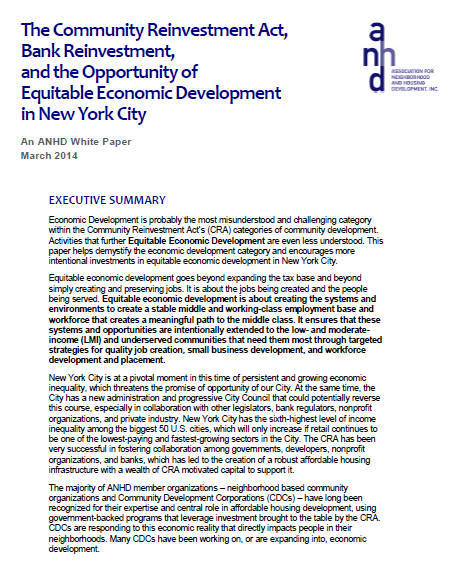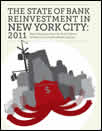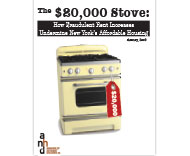Click on each title below to download ANHD’s most recent reports:
2017
Taking Care of Business: Understanding Commercial Displacement in New York City New York City’s small businesses are in the midst of a displacement crisis. As stores shutter and communities lose long-time institutions, the mechanisms and realities of this crisis are left under-examined. The Association for Neighborhood & Housing Development (ANHD) analyzed the economic vitality of small businesses across the city, neighborhood-by-neighborhood.
Trends in 1-4 Family Lending 2014 – 2016: Why is Non-Bank Lending Highest in Communities of Color? New York is a city of renters, but nearly a third of New Yorkers own their own homes. The stock of 2-4 family homes provides an important source of affordable rental housing in many neighborhoods. Secure and affordable homeownership has long been recognized as an important way for people to build wealth and move into the middle class. Yet, lower-income people and people of color have consistently been locked out of the housing market or targeted with harmful lending products and practices. In the years since the 2007 economic crisis, low- and moderate-income (LMI) New Yorkers and people of color have faced significant barriers to homeownership in New York City.
The For-Profitization of Affordable Housing Development and the de Blasio Plan Non-profit affordable housing developers have played a key role in New York City housing plans since the beginning of the modern, city-backed affordable housing model. The role of for-profit developers has grown over the years, leaving community development practitioners to question whether affordable housing development has become overly reliant on for-profit developers and whether the level of public benefit created by these projects has diminished.
ANHD uses newly available data to evaluate these questions in our latest white paper, The For-Profitization of Affordable Housing Development and the de Blasio Plan. Using information from the recent implementation of New York City Local Law 44, which requires developers to report certain project details, ANHD analyzes the for-profitization of affordable housing and compares some aspects of the relative role and the public benefit of non-profit and for-profit developers in Mayor de Blasio’s Housing New York Plan.
- Click here to read our section on Deposits and the Reinvestment Quantity & Quality Indexes.
- Click here to read our section on Branches and Banking Products and 1-4 Family Lending.
- Click here to read our section on Multifamily Lending and Community Development Loans & Investments.
- Click here to read our section on Philanthropy and CRA-Eligible Grants.
2017 How is Affordable Housing Threatened in Your Neighborhood? New York City Councilmember Jumaane Williams, the Chair of the Housing Committee, and the Association for Neighborhood & Housing Development (ANHD) jointly released the latest edition of ANHD’s annual data graphic, 2017 How is Affordable Housing Threatened in Your Neighborhood? The affordable housing risk chart is released each year with a variety of indicators of key threats to affordable housing in our city, laid-out at a neighborhood-by-neighborhood level in a user-friendly visual format. The risk chart is designed to allow each reader to notice issues and patterns that are especially critical in their individual neighborhoods, as well as the City as a whole. The information is presented to help community groups and policy makers develop effective strategies to address the affordable housing crisis.
What Happened To Housing Development When 421a Was Suspended? An ANHD White Paper, February 2017: The real estate industry has long claimed that the 421a tax exemption is absolutely necessary to get new rental housing built in our City and that this justifies the enormous cost of the program. But new data and recent reports from policy experts show this is not true. In fact, the 421a exemption likely has been making new housing development more difficult all along by inflating land prices.
2016
How is Economic Opportunity Threatened in Your Neighborhood? On November 16, 2016, ANHD releases an updated version of our What Does Your Neighborhood Economy Look Like? 2016 Equitable Economic Development Indicators risk chart, this year titled, How is Economic Opportunity Threatened in Your Neighborhood? This year’s chart features a citywide analysis broken down by neighborhood and grouped into the following categories: Access & Benefits, Housing, Work & School, and Infrastructure.
Pay Gap Tells Tale of Two Techs: ANHD’s research found a major pay gap in the tech industry, with people of color earning as little as half as their white counterparts.
State of Bank Reinvestment in New York City: 2015. ANHD’s comprehensive report on CRA giving by New York City-based banks published 2016.
Click here to download the report
Click here for Chart: How Well Are NYC’s Banks Serving Our Communities?
Click here for Chart: Reinvestment Volume Index & Quality Score
Who Gets Left Out When We Don’t Serve 30% AMI? If the City’s Mandatory Inclusionary Housing (MIH) plan doesn’t serve 30% AMI, MIH will leave out nearly 30% of New Yorkers. ANHD’s new map – WHO GETS LEFT OUT, WHEN WE DON’T SERVE 30% AMI? – shows the areas where MIH serving below 40% AMI is most critical for the local residents. Below are the maximum incomes and hourly wages that each AMI level can serve as reported in the City’s study:

Enhanced Business Areas & 25 Kent: NYC’s Commercial/Industrial Zoning Proposal Unpacks the details of NYC’s Enhanced Business Area tool, addresses question of whether such a tool works to further the goals of the Mayor’s Industrial Plan, and presents ways in which the proposal can be improved to fully be accountable to industrial and manufacturing neighborhoods and the communities they employ.
Who is Lending and Who is Getting Loans?: Trends in 1-4 Family Lending in New York City ANHD shows racial disparities in lending in NYC and on average, just 7.2% of home purchase loans went to low- and moderate-income borrowers in 2014, down from 7.5% in 2013.
Testimony of Barika X. Williams (ANHD staff) Before the New York City Council Subcommittee on Zoning and Franchises Regarding the Proposed “Mandatory Inclusionary Housing” Text Amendment ANHD asks City Council to: 1) Add a Deep Affordability option of 30% affordable housing at 30% AMI, 2) Require all MIH options include a set-aside of 15% of units at the 30% AMI level, 3) Eliminate the current ‘Gentrification Option,’ the 30% set aside at 120% AMI option, 4) Require that off-site MIH developments set aside an additional 10% affordable units, 5) Increase the number of MIH options to 5, to address the range of diverse neighborhood needs.
Mandatory Inclusionary Housing Deep Affordability Option Analysis Unfortunately the City’s MIH proposal primarily targets the 60% Area Median Income (AMI) and above level that are already served by our current housing programs, leaving out more than 40% of New Yorkers that earn below these levels.
ANHD’s Summary of Mayor deBlasio’s Mandatory Inclusionary Housing (MIH): Affordability levels will be set and voted on in a citywide text amendment – affordability levels will not be adjustable after this vote.
2015
ANHD’s AMI Cheat Sheet: ANHD’s AMI Cheat Sheet/Wallet Card gives you the information you need in a clear, visual form, including how each AMI % translates to: 1) A household income amount, 2) A monthly rent for that apartment, 3) The % of New Yorkers at each AMI level, and 4) The affordable housing construction category as used by the City.
A Missed Opportunity: The City’s Mandatory Inclusionary Housing Proposal Should Not Short-Change New Yorkers. Unfortunately, the de Blasio Administration’s current MIH proposal misses the opportunity to create the guaranteed, truly affordable housing that many neighborhoods are demanding.
Mandatory Inclusionary Housing: ANHD Charts the City’s Proposal ANHD’s quick scan graphic of NYC’s new MIH proposal.
Mandatory Inclusionary Housing: Financial Feasibility and the Current City Proposal ANHD find gaps between MIH study and City’s proposal.
What Does Your Neighborhood Economy Look Like?: Equitable Economic Development Indicators ANHD’s latest research chart gives poverty indicators for each of New York neighborhoods. Click here for the PDF version.Click here for the interactive map
Permanent Affordability: Practical Solutions ANHD crunches the numbers to demonstrate how feasible it can be to build housing that’s permanently affordable.
NYC Inclusionary Zoning: A District-By-District Analysis of What Was Lost, Gained, & What Remains ANHD presents a district-by-district analysis of what was lost, gained and remaining in affordable housing in re-zoned areas.
421A Developer’s Tax Break: June 2015 Albany Reforms ANHD analyzes what Albany’s decision on the 421a Tax Break means for affordable housing production in 2015/16, particularly for housing New York’s lowest income residents.
A BILLION Dollar Opportunity for NYC: Expanding Bank Reinvestment Resources for Equitable Economic Development ANHD’s analysis finds that the percentage of local NYC economic development-related bank reinvestment is significantly lower than national averages.
Rent Laws & 421a Developer’s Tax Break Legislation: A Side-by-Side Comparison ANHD finds that the State Assembly proposal from Assembly Man / Housing Chair Keith Wright’s office offers the best plan for affordable housing for low AMI New Yorkers.
How is Affordable Housing Threatened in Your Neighborhood? 2015 ANHD’s annual community-by-community listing of affordable housing at risk of going market-rate,
Does Your District Have a Comprehensive Housing Preservation Plan?Survey shows that thousands of low-income New Yorkers receive assistance thanks to Council funding.
shows that thousands of low-income New Yorkers receive assistance thanks to Council funding.
ANHD Testimony: Economic Growth and Regulatory Paperwork Reduction Act of 1996 (EGRPRA) Community Panel for Boston Outreach Meeting Federal bank regulators invited ANHD to present our analysis on the community panel at the EGRPRA outreach meeting at the Federal Reserve Bank of Boston.
State of Bank Reinvestment in New York City: 2014 ANHD’s comprehensive report on CRA giving by New York City-based banks, published 2015.
Click here to download Bank Report data chart
Click here to download Bank Report Chart of Reinvestment indexes
Communities First: A Community Platform for Equitable Neighborhood Planning ANHD recommends that the City housing plan include ensuring that affordable housing is truly affordable for local residents, that apartment sizes match average family sizes, that traditional residents not be displaced by new developments and that communities have input in planning. March 2015
421a Developer’s Tax Break expiring June 2015: Fix it or End it ANHD lays out the problems with the 421a Tax Break for housing developers – and recommends solutions.
421a Developer’s Tax Break expiring June 2015 ANHD examines the 421a Developer’s Tax Break including a community-by-community analysis of all the properties that received this tax break in FY 2013.
2014
Social Resiliency and Superstorm Sandy: Lessons from New York City Community Organizations As Part I of two new white papers, ANHD examines how local NYC neighborhood groups responded to the storm, and the lessons that this holds for policy makers and practitioners working to implement true “social resiliency.”
How Many Units Could Be Created Under Mandatory Inclusionary Zoning? ANHD crunches the numbers to show how – instead of building just 2,800 units through the Bloomberg inclusionary zoning plan – the de Blasio administration has the opportunity to create 32,000 units. ANHD shows how.
What has Inclusionary Zoning meant for BROOKLYN COMMUNITY BOARD 7? ANHD crunches the numbers on prior losses, and potential gains of affordable housing for Brooklyn’s CB 7.
What has Inclusionary Zoning meant for QUEENS COMMUNITY BOARD 1? ANHD crunches the numbers on prior losses, and potential gains of affordable housing for Queen’s CB 1.
What has Inclusionary Zoning meant for MANHATTAN COMMUNITY BOARD 11? ANHD crunches the numbers on prior losses, and potential gains of affordable housing for Manhattan’s CB 11.
Don’t Bank on It: The Responsible Banking Act ANHD’s guide for communities to help them gain more CRA dollars and services.
A New Era of NYC Affordable Housing Policy?: Analyzing the Mayor’s Housing New York Plan a 5-part blog series from Moses Gates
How Much Did the Real Estate Industry Benefit in the Bloomberg Years? In exchange for developments valued at $7.8 billion, the real estate industry produced a paltry 2,800 affordable units in re-zoned areas.
A 50,000 Job Challenge: Creating Quality Jobs in the New Industrial New York – Executive Summary
Inclusionary Zoning: Lost Opportunities for Affordable Housing ANHD counts the affordable housing units that should have been built – but were not – during the Bloomberg years.
How is Affordable Housing Threatened in Your Neighborhood? 2014 ANHD’s annual community-by-community listing of threatened affordable housing units
State of Bank Reinvestment in New York City: 2013 Annual analysis of banks rate of servicing neighborhood credit needs in accordance with the Community Reinvestment Act
Click here to download 2013 Bank Report data chart
Click here to download 2013 Bank Report Chart of Reinvestment indexes
2013
Mandatory Inclusionary Zoning: Ensuring Affordability is a part of New York City’s Future White Paper ANHD sets a new policy for Mandatory Inclusionary Zoning to increase to 20% to 30%
Real Affordability: An Evalution of the Bloomberg Housing Program and Recommendations to Strengthen Affordable Housing Policy ANHD’s research finds that 1/3 of subsidized housing built in NYC since 2003 is unaffordable for local residents. Report includes tools to help city and local organizations gauge how well proposed housing will meet community needs.
Affordable Neighborhoods: 2013 Housing Policy for the Future of New York City ANHD’s research and recommendations on affordable housing policies for the next mayoral term.
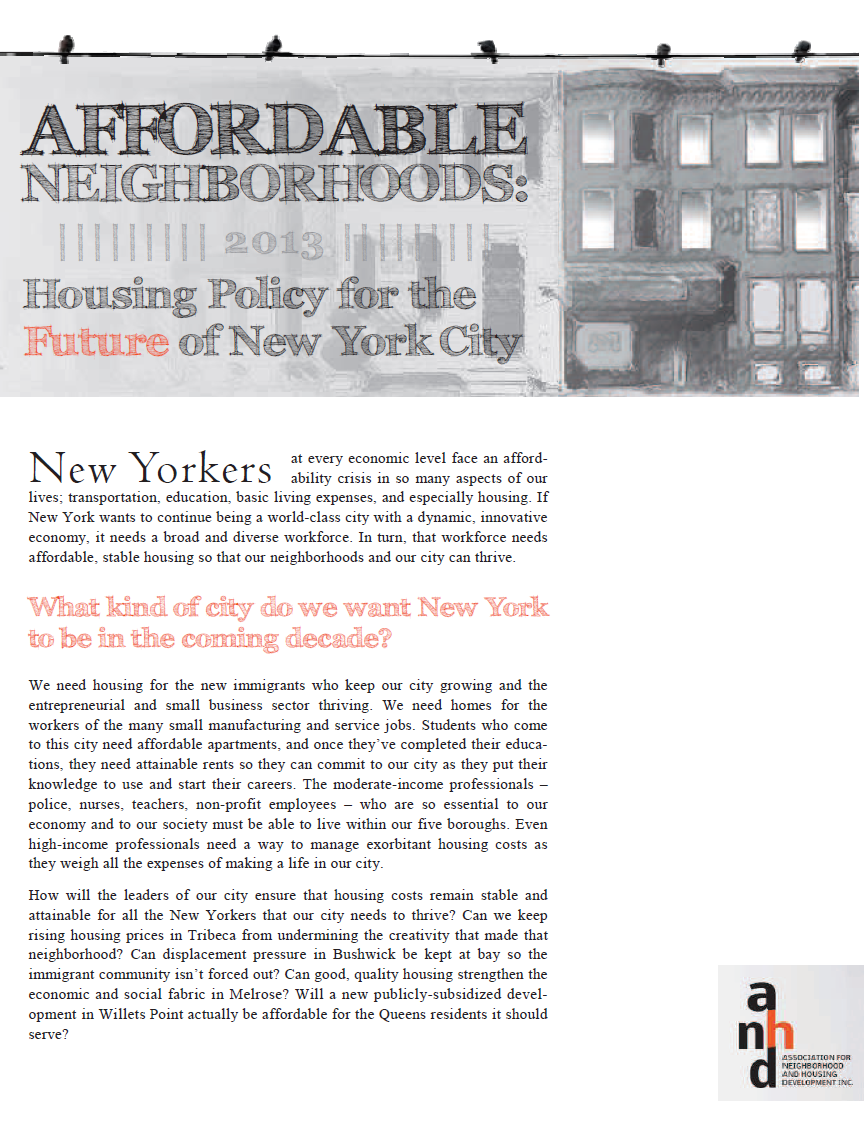
The State of Bank Reinvestment in New York City: 2012 Annual analysis of banks rate of servicing neighborhood credit needs in accordance with the Community Reinvestment Act.
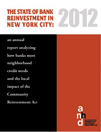
2012 and prior to 2012
From Collaboration to Transformation: The Initiative for Neighbohood and and Citywide Organizing & The Power of Grassroots Community Development As the little engine that could, this group of grassroots organizations led by ANHD leveraged $1.3 billion for affordable housing in NYC and achieved passage of legislation to help thousands of low-income tenants.
Keeping Banks Accountable to our Communities: Report from a National Convening on Local Responsible Banking Ordinances ANHD’s 2011 national convening that led to the 2012 passage through New York City Council of the most comprehensive RBA in the US
The State of Bank Reinvestment in New York City: 2011 Details sharp decreases in lending by the City’s largest financial institutions
CDCs and The Future of New York: Building for the Community and Building for a Stronger City The many contributions community development corporations(CDCs) have made throughout New York City
Leveraging Tax Abatements to Achieve Permanent Affordability How New York City can achieve permanent affordability by using tax incentives to maximize the return on investment in both new construction and substantial rehabilitation projects.
State of Bank Reinvestment in NYC: 2009 Details the sharp decrease in the amount of lending and services in working class neighborhoods provided by the City’s largest financial institutions, ranks the banks, and highlights several institutions that have engaged in destructive lending practices.
Permanent Affordability: A National Conversation The convening of key stakeholders from the affordable housing community, including local and national housing agencies, policy experts, not-for-profit developers, and advocates. The purpose of this forum was to engage in a discussion of challenges and opportunities related to ensuring permanent affordability in subsidized housing.
Predatory Equity Report Impending default crisis for 100,000 New York City affordable apartments

The $20,000 Stove: How Fradulent Rent Increases Undermine New York’s Affordable Housing Analysis of fraud in the 1/40th rent increase program and how lax oversight is undermining affordable housing
The Making of a Movement: How Organizing is Transforming Housing in New York City Recent important housing policy changes, and the strategies that neighborhood-based housing groups used to achieve these victories. The report highlights the role of community organizing and ANHD member groups through the Initiative for Neighborhood and City-Wide Organizing
Save Our Homes: A Call to Action How NYC can preserve 77,000 affordable apartments that are at risk of losing their HUD subsidies
Homeownership Stabilization Initiative: Final Evaluation
Affordable Housing at a Crossroads: Not-for-Profit Housing Production in the New Marketplace Comprehensive assessment of the landscape for affordable housing production
Inequitable Enforcement: The Crisis of Housing Code Enforcement in New York City Co-authored with the NYC Comptroller assessing code enforcement policy and laying out recommendations for change
 ANHD 2016 Building the Community Development Movement
ANHD 2016 Building the Community Development Movement


